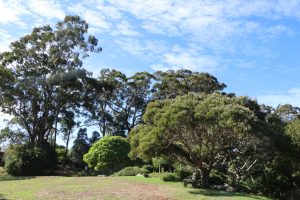
Established 23-years-ago, Waimea Nature Park is the go-to place for family fun. Operated and maintained by the Waimea Branch of The Outdoor Circle the park was a tangled mess of invasive trees with the ground covered in Christmas berry.
Cheryl Langton is the current president of the local The Outdoor Circle Group. “The park started when people realized there were fewer and fewer open spaces in Waimea, not many parks and a lot of private land. Carol Hendricks, a past president of The Outdoor Circle was instrumental in starting the park and worked for more than six years to get a lease from the State.”
Carol Hendricks passed away in 2018 but her husband Pete is one of several dozen regular and erstwhile volunteers who show up every week to whack weeds, clear invasives, mow the lawn, and tidy the place up. Langton added, “Some of our volunteers, have been here from the beginning. Now, they’re in their 70s and 80s, and some have passed on.”
One, Leningrad Elarionoff, just passed in September at the age of 83. It’s fair to call him the ʻōhiʻa man of the Waimea Nature Park.
“All of the new plants that you see in the park are native Hawaiian. We have the largest collection of ʻōhiʻa trees anywhere in the state and all are different colors. Most of them were brought here by Leningrad,” Langton said.
In an interview, several months before his death, Elarionoff said, “We have a collection here of about nine different colors of ʻōhiʻa lehua. When people come here, they cannot believe there’s so many different colors.”
Over the years he became an expert on ʻōhiʻa, immersing himself in not only the natural history of the tree, but it’s cultural history as well. The Hawaiians believed that ʻōhiʻa and lehua, ʻōhiʻa is the male and lehua is a female have flowers reflecting emotions, which can go from an angry red to a very pleasant, nice, sweet almost white.”
The work of the volunteers, past and present, embodies the whole spirt of community-based forestry.
Heather McMillen leads the DLNR Division of Forestry and Wildlife (DOFAW) Kaulunani Urban and Community Forestry Program. “Waimea Nature Center (park) was one of our first community grants, which supported the purchase of trees. The founders and volunteers have done so much more than just plant. They’ve transformed empty, weed-choked ground to into a verdant native forest where many different people come to enjoy. The number of people the park reaches, and the number of volunteers is remarkable. Many school classes visit the park for ecology, botany, forestry experience, and more,” McMillen explained.
She added, “They not only planted ōhi’a but also raised awareness of Rapid ʻŌhiʻa Death when it began impacting the park. They were totally on it! Although they lost a couple trees, they reached out right away for technical assistance and were proactive in management.”
This morning, DLNR First Deputy Bob Masuda, a resident of Waimea, honored Carol Hendricks, Leningrad Elarionoff, and the Waimea Nature Center with DLNR & YOU Citizen Conservationist Awards. Hendricks and Elarionoff family members were on hand to accept the posthumous awards.
“I personally have lovely memories of being at the park with Leningrad and Cheryl. Cheryl gave us an intro to the place and Leningrad entertained and educated our Kaulunani Council with many stories. He also shared ōhi‘a pen holders he had created himself from fallen ōhi‘a. It sits on my desk as a reminder of Leningrad and the generosity of spirit he shared,” McMillen commented.
Langton concluded, “There’s this misconception that everybody in Waimea is wealthy and truthfully for a lot of people in this community, this is the only place they have to be outdoors, to picnic, to gather with family and friends. We have five public and private schools within walking distance of this park. It’s a good place for them to do community service. It’s a safe place to walk, you don’t have to worry about traffic. It’s open every day of the week, it’s free, and it’s just a wonderful resource for the community. I think it’s a really great achievement, we’ve done a lot.”